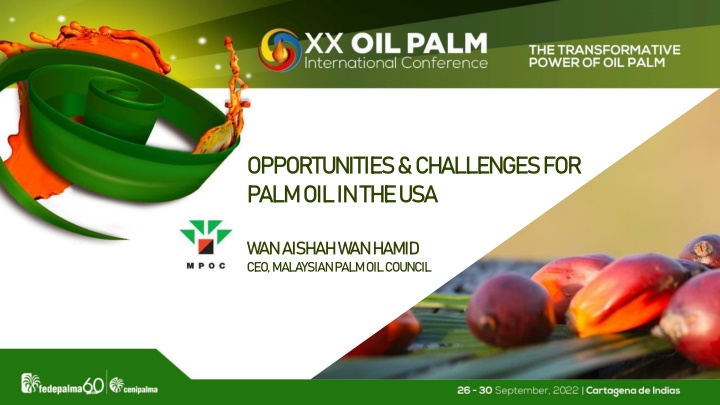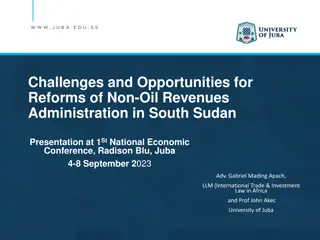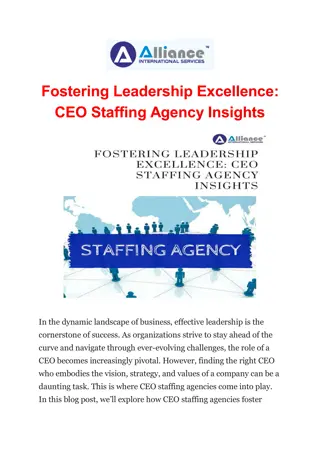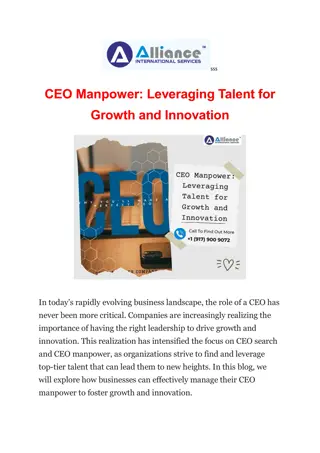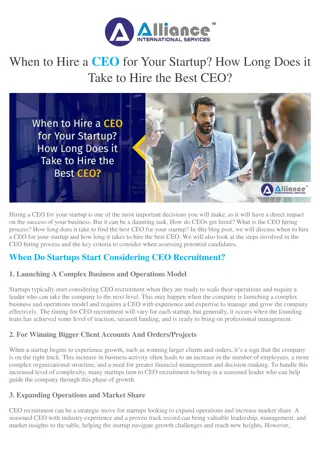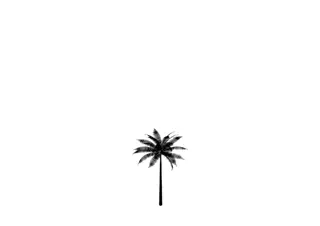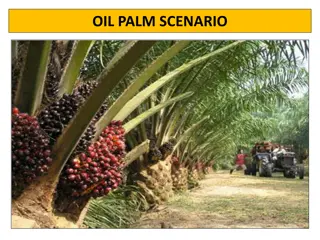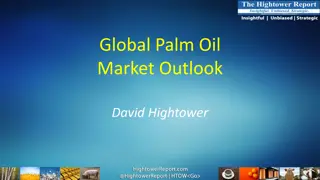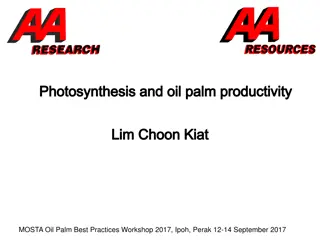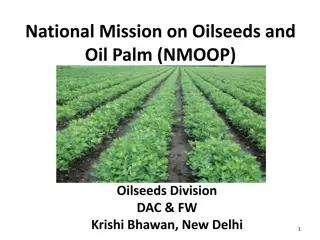Opportunities and Challenges for Palm Oil in the USA: Insights from Malaysian Palm Oil Council CEO
Explore the evolving landscape of palm oil in the USA through a presentation by Wan Aishah Wan Hamid, CEO of the Malaysian Palm Oil Council. Discover strategic approaches, market insights, and the global dynamics influencing palm oil production and consumption. Gain a deeper understanding of projected trends and the role of palm oil in the food, biofuel, and oleochemical industries.
Download Presentation

Please find below an Image/Link to download the presentation.
The content on the website is provided AS IS for your information and personal use only. It may not be sold, licensed, or shared on other websites without obtaining consent from the author.If you encounter any issues during the download, it is possible that the publisher has removed the file from their server.
You are allowed to download the files provided on this website for personal or commercial use, subject to the condition that they are used lawfully. All files are the property of their respective owners.
The content on the website is provided AS IS for your information and personal use only. It may not be sold, licensed, or shared on other websites without obtaining consent from the author.
E N D
Presentation Transcript
OPPORTUNITIES & CHALLENGES FOR PALM OIL IN THE USA WAN AISHAH WAN HAMID CEO, MALAYSIAN PALM OIL COUNCIL
Global Oils & Fats Dynamics Americas Oils & Fats Dynamics USA Oils & Fats Dynamics Presentation Outlines Opportunities & Challenges for Palm Oil in the USA Strategy: Malaysia's Way of Capturing the Market Summary & Conclusion
Oils & Fats Dynamics GLOBAL
Projected Oils & Fats Consumption vs Production According to an estimate, global human population will grow to over 9 billion by 2050 Food and Agriculture Organization of the United Nations(FAO) estimates the world will have to produce about 60 to 70 percent more food in the next 35 years, The gap projected demand and supply will continue to widen Source: Oil World, FAO, MPOC s estimates
1990 2021 Global Oils & Fats Production (1990 vs 2021) 80.89 mil MT 241.44 mil MT Others 12.50% Animal Fats 12.18% Others 16.94% Sunflower oil 7.86% Animal Fats 25.34% Sunflower oil 7.36% Soybean oil 24.91% Rapeseed oil 11.12% Rapeseed oil 11.66% Soybean oil 22.44% Palm oil 16.26% Palm oil 31.43% Source: Oil World
Global Oils & Fats Consumption Palm Oil s Contribution Direct Food Usage (66%) Sunflower oil 9.0% Rapeseed oil 10.6% Biofuel (17%) Soybean oil 24.4% Animal fats 7.9% Oleochemical(14%) Others 16.2% Feed (1%) Palm oil 31.8% Others (2%) Source: Oil World *Untapped biomass potentials
Global Oils & Fats Dynamics Net Importers & Exporters India China,PR EU-27 Pakistan Bangladesh U.S.A Iran Nigeria Korea,South Mexico Japan S.Africa,Rep Turkey Philippines Taiwan Brazil Canada Russia Argentina Ukraine Malaysia Indonesia Source: Oil World (20,000) (15,000) (10,000) (5,000) - 5,000 10,000 15,000 20,000 25,000 30,000 35,000 1000 MT
Production Import Consumption 24732 AMERICAS Top 6 Oils & Fats Producers in 2021 21719 12587 11992 10241 5573 5276 3560 ( 000 MT) 2873 2407 2135 1957 1283 1615 994 523 523 25 Source: Oil World USA BRAZIL ARGENTINA CANADA MEXICO COLOMBIA
1710 Colombia AMERICAS Palm Oil Producing Countries 620 Brazil 350 Equador 232 Peru ( 000 MT) 118 Mexico Source: Oil World 0 200 400 600 800 1000 1200 1400 1600 1800 2021 2020 2019 2018
1620 AMERICAS Palm Oil Imports in 2021 ( 000 MT) 483 358 170 150 102 52 Source: Oil World USA MEXICO COLOMBIA BRAZIL HAITI CANADA VENEZUELA
Jan-Dec 2021 Jan-Dec 2020 Change (MT) Country AMERICAS Malaysian Palm Oil Imports USA 268,625 540,349 (271,724) Canada 13,212 12,905 307 Guatemala 11,950 1,219 10,731 Brazil 8,546 9,141 (595) ( 000 MT) Trinidad 7,711 6,167 1,544 Other Americas Total 24,619 334,663 42,207 611,988 (17,588) (277,325) Source: Oil World
USA Oils & Fats Dynamics
U.S. Palm Oil Import Data issued by U.S. Census Bureau indicated that total palm oil imports into the U.S. from Jan-May 2022 amounted to 682,000 T. Malaysia s market share was 9.5% USA Market Snapshots Palm Oil Entry Points TheEastCoastportsremainthemajorentrypointsforpalmoilintotheU.S.Port of New Orleans, Savannah and Newark handled 79% of palm oil imports in Jan- May2022 Oils & Fats Applications Foodapplications accounted forthehighest marketsharein theNorthAmerica vegetableoilsmarket U.S. Market Outlook In 2021, U.S. total oils and fats imports amounted to 5.57 Mn T. Palm oil imports constitute29percentofthetotalimports.
25000 20000 USA 15000 000 MT Balance of Oils & Fats ( 000 MT) 10000 5000 0 2021 21719 5573 24732 2020 21588 5219 23861 2019 21153 5241 23928 2018 21154 5108 23823 2017 20113 5056 22557 Production Import Consumption Production Import Consumption Source: Oil World Source: Oil World, MPOC market analysis Source: Oil World
CONSUMPTION 2021 IMPORT 2021 USA Biggest Importer and Consumer in Americas Others 15% Others 15% Rapeseedoil 34% Soybean Oil 43% Oliveoil 7% Tallow 17% Coconutoil 8% Palm Oil 6% Corn Oil 9% Rapeseed Oil 10% Palm oil and Palm kernel oil 36% Total oils and fats import : 5.57 million MT Total oils and fats consumption in 2021 amounted to 24.7 million MT Source: Oil World Source: Oil World, MPOC market analysis
Oils & Fats Balance Import / Export Domestic Production The US is one of the top global producer of soybeans andsoybeanoil 7000 22000 6000 21000 USA Oils & Fats Dynamics 5000 20000 Despite growth production, increasedy-o-y positive of imports y-o-y domestic 4000 19000 also 3000 18000 ( 000 MT) This decliningexporttrends is underpinned by 2000 17000 1000 16000 This is a clear picture of USA s increasing gap for oils & fats which indicates vast potentialforpalmoil 0 15000 2017 2018 2019 2020 2021 Source: Oil World, FAO, MPOC s estimates Total Import Total Export Domestic Production
CHALLENGES for Palm Oil in the USA OPPORTUNITIES & CHALLENGES for Palm Oil in the USA
USA Cooking oil Salad Dressings Baked Goods Crackers Barbecue Sauce Shortening Non-dairy Creamers Potato Chips Mayonnaise Breads Whipped Topping Vegetable Oil Consumption ( 000 MT) Source: Oil World, MPOC market analysis
The U.S. Census Bureau projects the United States population will be 332,403,650 on Jan. 1, 2022. Potential in the USA This represents a 0.21% increase in population or an additional 706,899 people since New Year s Day 2021. Continued growth for food industry
USA Retail and Food Service Sales VS Palm Oil Import 8 1800 1600 Potential in the USA 7 1400 Palm Oil Import ('000 MT) 6 Sales in trillion USD 1200 5 1000 4 800 Food Services 3 600 2 400 1 200 0 0 20002001200220032004200520062007200820092010 2011 2012 2013 2014 2015 2016 2017 2018 201920202021 Source: USDA and US Census Bureau Sales PO Import
USA Health & Beauty Products Sales VS Palm Oil Import 250 1800 1600 Potential in the USA 200 1400 Palm Oil Import ('000MT) 1200 Sales in billion USD 150 1000 Health & Beauty Products 800 100 600 400 50 200 0 0 Source: USDA and US Census Bureau 2003 2004 2005 2006 2007 2008 2009 2010 2011 2012 2013 2014 2015 2016 2017 2018 2019 2020 Sales PO Import
Increasing demand for processed food and foodservice industries Demographic growth and diversified ethnicities Continued Potential of the USA Increasing utilization of palm oil and its derivates in non-food uses Rising awareness on healthy lifestyle Growing outlets to obtain food; food delivery, phone app Source: Oil World, MPOC market analysis
Nutrition (Tropical Oil / Saturated Fats) In 1984, CSPI organized the first national campaign to pressure fast- food restaurants and food companies to stop frying with beef fat and tropical oils, which are high in the cholesterol-raising saturated fats thatincreasetheriskofheartdisease. Weallknowtherealproblemistransfatfrompartiallyhydrogenated vegetableoilandsaturatedfathasnocorrelationwithCHDs But, the stigma of saturated fat still lingers in the minds of the Americans
Climate Change ForestAct2021 The U.S. Congress were set to unveil legislation to reduce illegal deforestation globally by restricting the trade of certain agricultural commodities. Companies would have to improve their tracking of supply chains for certain commodities, especially palm oil, cocoa, soy and cattle products, as well as rubber and wood pulp, to prove they come from areasthathavenotbeenillegallylogged.
Forced Labour Between 2016-2021 the uptick in WROs was even more profound. In that period, CBP issued 36 WROs on goods from eight countries and fishing vessels, 64 percent of which occurred in 2020 (15) and 2021 (eight) IfCBPfindsthattheinformation"reasonablybutnot conclusively" indicates the use of forced labor under Section 307, and the good is being imported or is likely to be imported, the agency will issue a WROandwilldetainthegoodscoveredintheorder.
STRATEGY Malaysia's Way of Capturing the Market
Strengthening Local Policies to Meet Global Demand National Action Plan on Forced Labour inter-ministerial collaborations (13 Ministries) to ensure that no forced labour throughout all key industries in Malaysia IncludeRatificationofILO sArticle29onforcedlabourbyMalaysia Malaysian Sustainable Palm Oil (MSPO) certification a government commitment, making sure environmental protection and forced labour are key components for the Malaysian palm oil industry no new planting on natural forests, HCV, SIA assessments, GHG emissions scheduled plan for improvements
Palm Oil Image Building WorkwithLocalConsultant Work with local consultant to understand on the ground issues and sentiments on palm oil and related industries and later strategize the bestwaytocommunicate therightinformation UseofMedia Use conventional and digital media to disseminate positive palm related information, andcreatemeaningful dialogue UseofTechnology Improved transparency and traceability of palm oil supply chainthrough MSPO Trace system that is available onlineand on mobile apps. Plans to puttoblockchaintoimprovecredibility.
Stakeholders Engagement Industry Discussions on market updates, Malaysia s policies that facilitate trade i.e. NAPFR and potential products where palm oil and its derivatives can be used with manufacturersandtraders Discussionwithlocalassociationsandagenciesi.e.AmericanSoybeanBoard The 12th Palm Oil Seminar Series (POSS) Seattle, Washington, Interaction and networking session with senior officials of the United Soybean Board (USB), Promoting palm-based animal feed and animal nutrition products at the World DairyExpoinMadison,Wisconsin Government Ministerial visits, discussions with CBP and ILO to inform Malaysia s efforts in mitigatingissuesraised Awareness program with all foreign missions in the USA to get them informed on thelatestinformationonpalmoil PassportDC,WashingtonDC,USA
Stakeholders Engagement SubjectMatterExperts,SocialInfluencers,Users Work with nutrition professors, chefs, restaurant owners, health influencers through programs that demonstrates the goodness of palm oilintheirrespectivefields Cooking demonstration and food tasting sessions at the Worlds of Flavor event in California, Palm oil workshop at the Worlds of Flavor event, Cooking demonstration for the Asian food catering and food servicesectorsandpalmoilbriefinginFlushing,NewYork Consumers Make consumers understand through ground activation activities to answeralltheconfusionscreatedbyantipalmoilNGOs Roadshows, in collaboration with local companies to create awareness onpalmoil spositiveattributesandsustainabilityefforts
Summary ProducingCountriesNeedtoWorkTogether All palm oil producing countries need to band together and put in a concerted messaging on how palm oil is actually part of the solution to globalfoodsecurity Acknowledge each other s efforts by creating a common standards that willbeusefortradetoprovequality/sustainability Stronger lobby and put pressure on anti-palm oil campaigns around the worldbypullingresources,orembedinlocallegislationtohaltproducts orcountrythathaveblatantanti-palmoilpolicies TOGETHER, wecanWIN!
